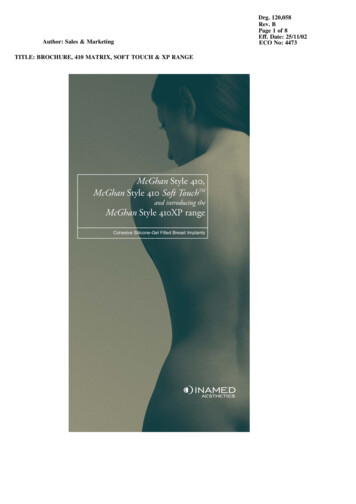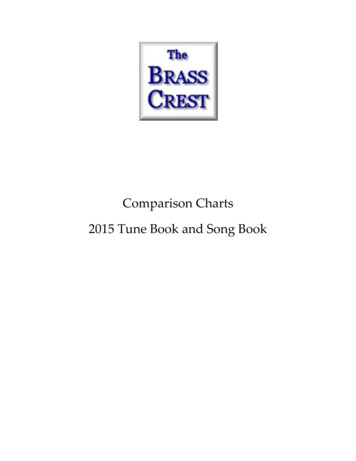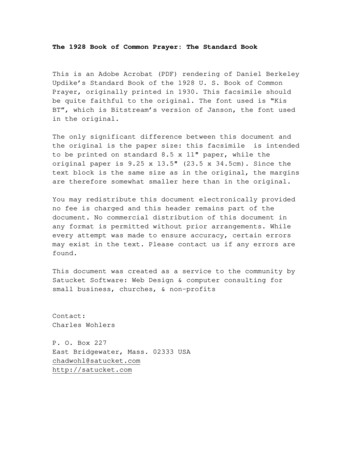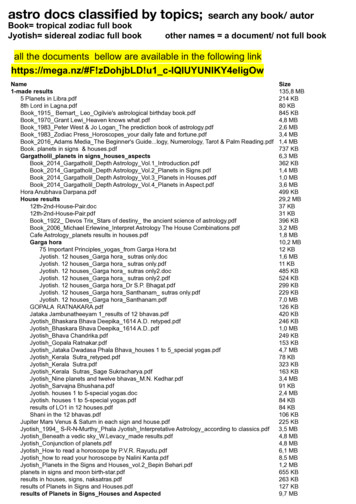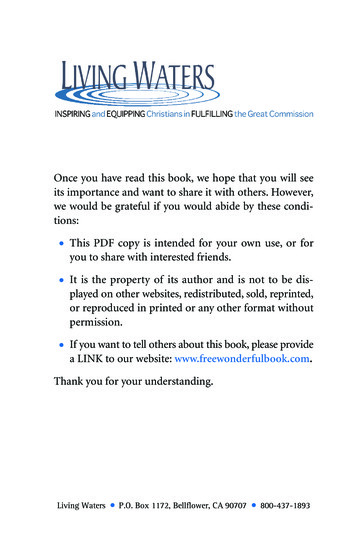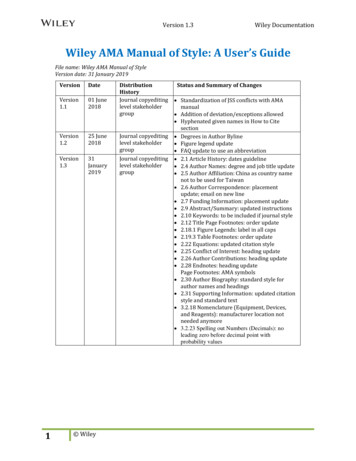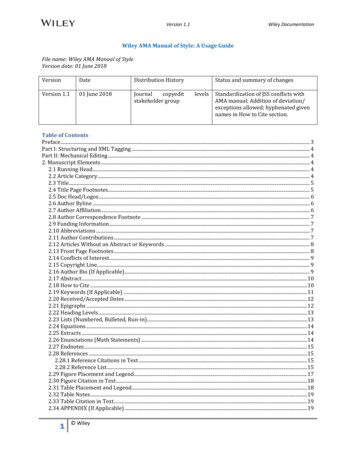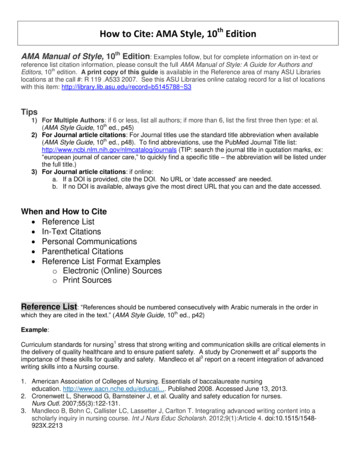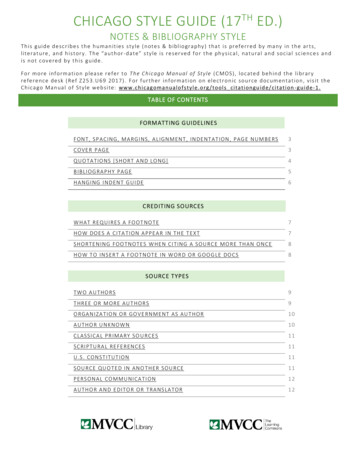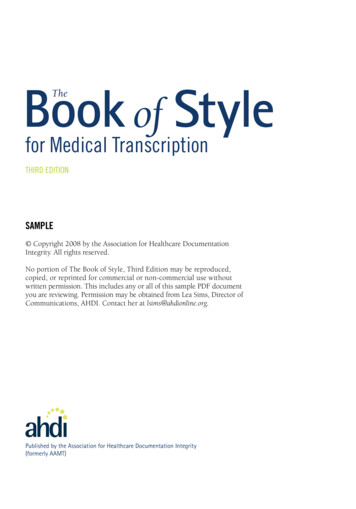
Transcription
Book of StyleThefor Medical TranscriptionTHIRD EDITIONSAMPLE Copyright 2008 by the Association for Healthcare DocumentationIntegrity. All rights reserved.No portion of The Book of Style, Third Edition may be reproduced,copied, or reprinted for commercial or non-commercial use withoutwritten permission. This includes any or all of this sample PDF documentyou are reviewing. Permission may be obtained from Lea Sims, Director ofCommunications, AHDI. Contact her at lsims@ahdionline.org.For coated:Blue: 534Green: 382For uncoated:Blue: 547Green: 380Published by the Association for Healthcare Documentation Integrity(formerly AAMT)
Section 1: The Legal Medical RecordCHAPTER2Chapter 2: Editing the 62.1.72.1.82.1.9If transcriptionists were only required to “type what they hear” and applythe standards as outlined throughout this book, the role would be a relatively straightforward and unencumbered one. There are some in healthcare who advocate this kind of restricted role for documentation specialists,embracing a “verbatim” transcription policy that limits the MT to transcribing only what is dictated, whether right or wrong, and flagging discrepancies for review by the dictator. In most environments, however, there is theexpectation that the MT will be actively engaged in the diagnostic story-telling of the patient encounter, noting discrepancies in grammar, style, andclinical information, and correcting those discrepancies that fall within thescope of the MT’s knowledge and informed judgment. Certainly, routingdiscrepancies back to the dictator that could have been reasonably correctedby the transcriptionist has a direct impact on turn-around time and reimbursement. Such a restrictive policy for editing and correction can be costlyto the facility and burdensome to the medical records department who hasto facilitate those corrections. A skilled, engaged MT partners with the physician to ensure an accurate, timely, and secure record.AHDI recognizes that MTs are not engaged in provision of patient care andcannot be expected to have insight into the patient encounter beyond whatis provided by the dictator. However, many discrepancies encountered indictation represent areas of obvious error where correction falls within thescope of the interpretive skill set and clinical knowledge of the MT.(See Appendix B—Statement on Verbatim Transcription.)When to EditGrammar/PunctuationSyntaxSpellingS lang, Jargon, and BriefFormsBack FormationsIncorrect TermsContextual InconsistenciesT ransposition of Termsand ValuesDemographics2.2How To Edit2.2.1 C ritical Thinking versusGuessing2.2.2 Clarifying Content2.2.3 Dictator Style2.2.4 A ccess to AncillaryRecords2.3When Not to Edit2.3.1 Missing/InaudibleDictation2.3.2 Irreconcilable Words andPhrases2.3.3 Contradictory Information2.3.4 Direct Quotes2.3.5 Negative Findings2.42.4.12.4.22.4.3Notification and FlaggingBlanksAudio IndexingFlagging the ReportTranscriptionists who find themselves in a verbatim environment will haveno choice but to comply with facility policy, and the ability of those MTs toengage in informed editing and impact risk management will be extremelylimited. In those settings, an MT must stay within the guidelines of the verbatim standard, but AHDI urges even those MTs to be proactive in advocating for the role of the skilled MT in ensuring accurate capture and formatting of healthcare data.Chapter 2: Editing the Record23
2.1 When to EditA patient’s record is an important story, one that needs to accurately reflect theexchange of information that occurred between the provider and the patient during that encounter. Preserving the tone and scope of that encounter, while ensuring the accuracy of the data being captured, is critical to creating a long-term carerecord that is historically and clinically meaningful. The art of managing information that ensures this outcome falls within the skill set of the transcriptionist.Honoring a physician’s dictation style, recognizing error or inconsistency in therecord, correcting errors appropriately, refraining from correcting or altering whatcannot be confirmed, and notifying the provider of errors that cannot be corrected are all part of protecting the integrity of the patient care encounter.Trend Note: The computerized translation by a speech recognition engine ofdictated material results in text that usually needs considerable editing. This issometimes done on the front end by the originator but more often by a back-endspeech recognition editor (an experienced medical transcriptionist) who will review the text while listening to the original audio file to ensure that the data hasbeen captured and formatted appropriately. The same editing guidelines outlinedbelow that apply to transcription editing equally apply to editing a speech-recognized draft.2.1.1 Grammar/PunctuationEdit errors in grammar and punctuation, including dictator-provided instructions related to paragraph breaks and punctuation. Dictators, especially thosewho speak English as a second language, may struggle with effective grammar and appropriate punctuation. Common errors include poor subject-verbagreement and transposition of personal pronouns. Be careful also to listenfor errors in pluralization, especially where Latin and Greek plurals are concerned, and edit appropriately.exampleD: The anterior and posterior views of the chest was normal.T: The anterior and posterior views of the chest were normal.D: The patient had multiple diverticuli in the transverse colon.T: The patient had multiple diverticula in the transverse colon.2.1.2 SyntaxSyntax refers to the appropriate arrangement of words in a sentence. Wordorder is important to ensuring clarity of communication. Often, in the haste24Section 1: The Legal Medical Record
of dictation, providers will unwittingly dictate sentences with gross errors insyntax. While the result can be humorous, it is critical for the transcriptionistto edit these errors so that they do not lead to misinterpretation of meaning.ESL physicians are particularly prone to errors in syntax, as their native grammar structures often vary greatly from English syntax. While the vocabularyand concepts may be accurate, they will often need assistance from the MT inensuring appropriate word order and avoiding misplaced modifiers. Edit errors in syntax to ensure clarity of communication.exampleD: The patient developed a puffy right eye that was felt to be secondary to aninsect bite by the ophthalmologist.T: The patient developed a puffy right eye; this was felt by the ophthalmologistto be secondary to an insect bite.D: CT scan showed there was nothing in the brain but sinusitis.T: CT scan of the brain showed only sinusitis.2.1.3 SpellingWhile electronic spell checkers can be tremendously helpful in identifying andcorrecting misspelled words in the record, transcriptionists should not rely onthose resources alone, nor should the transcriptionist rely on dictator spellingof new terms, medications, equipment, or instruments unless that term cannotbe located or verified in any reputable resource. In that instance, it is best tospell the term as provided by the dictator and flag the report for verification(See 2.4.3—Flagging the Report). For all misspelled words for which a correctspelling can be verified, the transcriptionist should edit that term appropriately.2.1.4 Slang, Jargon, and Brief FormsModern medicine is constantly evolving and so is its language. In addition,with the fast pace of American health care, clinicians sometimes find themselves dictating their notes on the fly, before they have had a chance to puttheir thoughts together. The result may be an awkward use of language andfrequent neologisms. Edit inappropriate slang words and phrases, keepingin mind that many words start out as coined or slang terms but later evolvethrough usage to eventually become acceptable words in the American medical lexicon.To include a list of acceptable and unacceptable slang word, brief form, or jargon would be virtually impossible. Transcriptionists should consult a reputableChapter 2: Editing the Record25
industry reference book or resource to verify what terms are acceptable in theirshortened or altered forms and which terms should be edited.Sometimes a noun or adjective is used as a verb. If possible, edit awkwardlycreated verbs.exampleD: Stool was guaiac’d.T: Stool guaiac test was done.Likewise, if possible, edit proper nouns dictated as verbs.exampleD: The baby was de-lee’d on the abdomen.T: The baby was suctioned on the abdomen using a DeLee.Jargon refers to special language that is used and fully understood only bymembers of a particular craft, trade, or profession. Like other jargons, thatof healthcare professions parallels, but only slightly overlaps, formal technical terminology. It consists partly of lay and technical terms to which specialmeanings are assigned. It is largely unrecorded in reference books and ishighly informal, including some expressions that are slangy and humorous.Medical jargon tends to be particularly imprecise and may be offensive andderogatory.exampleD: urinesT: urine samplesD: premieT: premature infantD: orthopodT: orthopedic surgeonLeave blank and flag obscenities, derogatory or inflammatory remarks, anddouble entendres (words or word combinations, symbols, and abbreviationsthat have varying, and usually inappropriate, meanings) except when these arepurposefully dictated by the author as part of a direct quote. In instances26Section 1: The Legal Medical Record
where the inclusion is easily edited, do so to avoid misinterpretation or theretention of an inappropriate abbreviation or term.exampleD: He is complaining of some SOB.T: He is complaining of some shortness of breath.Brief forms are shortened forms of common words that are acceptable to transcribe in abbreviated format. These are discussed more fully in Chapter 9.Consult a reputable industry reference or resource when attempting to determine whether a dictated abbreviated form is an acceptable brief form or ispotentially an unacceptable slang, jargon term, or back formation.Examples of acceptable brief forms:exampleexamlabmonos, basos, lymphs, eosprepExamples of unacceptable brief forms:exampleappy (appendectomy)crit (hematocrit)epi (epinephrine)2.1.5 Back FormationsBack formations are new words formed by altering an existing word (usually a noun). Back formations are often verbs but may appear as adjectives oradverbs. They are frequently encountered in medical dictation. Use dictatedback formations if they have become acceptable through widespread use.Avoid absurd back formations or ones that will be confusing to the reader. It isdifficult to say which back formations will become accepted; this is ultimatelydetermined by usage. False verbs and other back formations are increasinglyprevalent in the communications industry and technical world, but theyshould be used judiciously in transcribed health records.Chapter 2: Editing the Record27
Examples of back formations that have evolved to acceptable and commonusage:examplediagnosis—to diagnoseBovie—boviedExamples of back formations that are not acceptable and should be editedappropriately:exampledehiscence—to dehiscetorsion—to torsediuretics—to diurese2.1.6 Incorrect TermsEdit incorrectly dictated English and medical terms when the intended meaning is unquestionably clear. This requires a transcriptionist to have skilledinterpretive judgment and the ability to recognize any ambiguity related to adictated term or phrase (See 2.2.1—Critical Thinking versus Guessing). If there isany doubt, leave a blank and flag the report.exampleD: At the time of discharge, the patient was feeling much better and no longerhad a temperature.T: At the time of discharge, the patient was feeling much better and no longerhad a fever.Note: In the above example, temperature was changed to fever because itwould be clinically erroneous to describe a patient, particularly one beingdischarged, as having no temperature. While it is common for people, evendictators, to use these terms interchangeably, clarity of communication dictatesthat the appropriate word (in this case fever) be used instead.exampleD: The baby was delivered over an intact peritoneum.T: The baby was delivered over an intact perineum.28Section 1: The Legal Medical Record
2.1.7 Contextual InconsistenciesMany contextual inconsistencies have to be flagged and referred to the dictator for verification, but some contextual inconsistencies can be resolved by acritically thinking transcriptionist. If, for example, the physician clearly identifies the patient as a female in the opening statements of the history, accidentalreferences to the patient as “he” or “him” elsewhere in the report should beedited by the transcriptionist and do not require notification of the dictator.Some ESL dictators (for example, those who are native to the Philippines)struggle with personal pronouns because such pronouns do not exist in theirnative languages. Likewise, it is common for a dictator to dictate erroneousdirectional and positional terms (like left and right), and when a clear delineation is evident in the record, the transcriptionist should edit appropriately. Donot guess. If in doubt, leave a blank and flag the report.2.1.8 Transposition of Terms and ValuesIt is not uncommon for a dictator to accidentally transpose words or values inthe haste of dictating. When it is extremely clear that those terms have simplybeen flipped or transposed, edit them appropriately. If there is any ambiguityor doubt about the transposition of those terms or the correlation of valuesto the appropriate terms, leave a blank and flag the report. Many transposedterms can be left unedited, as they do not alter meaning, nor do they impactgrammatical structure. However, some clinical and diagnostic phrases are typically expressed in a specific order and have common abbreviations associatedwith that word order. When those types of phrases contain transposed terms,edit them appropriately to reflect the common phrase.exampleD: Hemoglobin 42, hematocrit 17.T: Hemoglobin 17, hematocrit 42.D: Vaginal laparoscopic-assisted hysterectomyT: Laparoscopic-assisted vaginal hysterectomy (LAVH)2.1.9 DemographicsAccurate patient demographics are critical to managing health information,and every attempt should be made to ensure that accurate patient demographics (as defined by the facility) have been captured in the documentationprocess. Some demographics, like medical record number and date of service,are manually entered by the dictator via the technology interface. Others aredictated by the physician. Both capture methods are fraught with error, and insettings where the transcriptionist has access to the patient chart, chart manChapter 2: Editing the Record29
agement system, or Admission/Discharge/Transfer (ADT) data, the transcriptionist should refer to that data when selecting or transcribing demographics.Do not rely solely on dictator spelling of patient names nor the dictated ormanually entered medical record numbers, chart numbers, dates of birth, ordates of service.Trend Note: With most modern dictation platforms and many ASP models,the demographic or ADT information is captured automatically by the systemat the point of dictation and electronically associated with the transcribedrecord. Transcriptionists working under those models are often required toverify what has been captured by the ADT feed against the information beingdictated by the physician to ensure accurate demographic mapping. In settingswhere this is not automatic, the MT may have to manually access this information to verify demographics.2.2 How to EditError recognition is only the first step in ensuring accurate data capture. Managing those errors requires the transcriptionist to be engaged in critical thinkingthat has been shaped by knowledge of clinical terminology and the diagnosticprocess. The skilled, engaged transcriptionist should engage all of the strategiesbelow for appropriate and informed editing.2.2.1 Critical Thinking versus GuessingTranscriptionists should approach the editing process from the position ofinformed judgment. An MT should never guess when interpreting what hasbeen dictated or the accuracy of a term, phrase, or reference in the record.Only in instances where the transcriptionist’s interpretive skill and experience have shaped a high degree of accuracy and confidence in the appropriateareas of editing (as outlined above in section 2.1) should the MT be permittedto proceed with editing those areas. Postgraduate transcriptionists and newhires should be watched closely to evaluate consistency in error recognitionand interpretive judgment. In instances where even a skilled transcriptionistcannot confidently edit an error or inconsistency, the MT should leave a blankand flag the report.2.2.2 Clarifying ContentBe proactively engaged in capturing a patient encounter by paying close attention to the entire narrative and the information that has been relayed about thepatient. Encountered errors or questionable inclusions can often be clarified30Section 1: The Legal Medical Record
by content elsewhere in the report. When attempting to interpret a dictatedterm or phrase, search for context clues that will facilitate an informed editingdecision.2.2.3 Dictator StyleEditing what has been dictated to reflect grammatical or clinical accuracyshould be done in a subtle and nonintrusive manner. In general, MTs shouldnot edit syntax or diction unless it represents an error or potential for misinterpretation. Just because a sentence can be better worded does not mean thatit is wrong. When editing phrases, terms, and syntax, do so with respect fordictator style and employ the least intrusive strategy for correction.2.2.4 Access to Ancillary RecordsRefer to the patient’s record to clarify or correct content in dictation. In settings where the transcriptionist has access to the patient chart or previousrecords, refer to those records for verification of information when needed. Insettings where access to those records is restricted, the transcriptionist shouldleave a blank and flag the report.2.3 When Not to EditAs important as the ability to accurately edit errors and inconsistencies in therecord is the ability to recognize and acknowledge those instances when it isinappropriate for a transcriptionist to engage in editing or altering the dictatedrecord. The objective of quality assessment programs is to ensure that transcriptionists not only know when and how to edit, but when not to edit, and confidence in the skills of an MT is often based on whether that MT knows what to dowhen he/she cannot edit or are unsure of how to handle a questionable area ofthe record.2.3.1 Missing/Inaudible DictationIn any area of the record where the dictation is missing, has been cut off, iscomplicated by extraneous noise, is inaudible, or is hindered by the speed orpoor articulation skills of the dictator, the transcriptionist should not attemptto guess unless the missing term or phrase is extremely obvious (see below). Inmost instances, the only option is to leave a blank and flag the report.Chapter 2: Editing the Record31
exampleD: Temperature 98.6, pulse 60, and garbled dictation 122/77.T: Temperature 98.6, pulse 60, and blood pressure 122/77.D: The patient was sent home on garbled dictation and will follow upin the office.T: The patient was sent home on and will follow up in the office.2.3.2 Irreconcilable Words and PhrasesWhen every attempt has been made by the transcriptionist to research a questionable term or phrase and reputable resources have been consulted with noverification, the transcriptionist should leave a blank and flag the report, evenin instances where the term or phrase was specifically dictated and/or spelledby the physician.2.3.3 Contradictory InformationIn instances where there is clearly contradictory information in the record thatcannot be clarified contextually or in ancillary records, the transcriptionistshould leave a blank and flag the report.2.3.4 Direct QuotesWhen the dictator provides information in the form of a direct quote, thetranscriptionist should be careful not to edit that information, as the dictatormay be intentionally including incorrect terms or references that were statedby the patient.exampleD: The patient believes her husband may have early quote old timer’sdisease unquote.T: The patient believes her husband may have early “old timer’s disease.”not:T: The patient believes her husband may have early “Alzheimer disease.”2.3.5 Negative FindingsNever delete negative or normal findings if dictated. To do so could potentiallyimply that those areas were not evaluated. Remember that a negative or normalfinding is a finding, often as diagnostically significant as a positive finding.32Section 1: The Legal Medical Record
2.4 Notification and FlaggingThe standard process for notifying either the quality assurance department orthe provider of an error or inconsistency in the record is to leave a blank andflag the report to the attention of an accountable party who will need to reviewthat blank and correct it.2.4.1 BlanksLeave a blank space in a report rather than guessing what was meant or transcribing unclear or obviously incorrect dictation. In many instances, leavinga blank means including an underlined section equivalent to the perceivedlength of questionable content. In other instances, it may mean leaving a blankspace or a text marker or tag that can be searched for by the QA person whowill review the flag (see examples below). Transcriptionists should defer tofacility/client preference for managing flagged areas of the record.exampleThe patient came in today complaining of for the last 3 days.The patient came in today complaining offor the last 3 days.The patient came in today complaining of ### for the last 3 days.2.4.2 Audio IndexingWith many dictation systems, it is now possible to index the dictation oraudio file at points where there is a question or potential error in the record.This enables QA personnel to jump quickly to that portion of the dictation toresolve flagged issues. On proprietary transcription systems, it is also possiblefor the indexed audio file to be automatically linked to the blank or tag in therecord. This greatly facilitates the QA and review process, and transcriptionistsshould defer to company or facility procedures for audio indexing.2.4.3 Flagging the ReportAt one time, flagging simply referred to the process of leaving a note at theend of the record that would draw the attention of medical records personneland/or the physician to a blank or inconsistency in the record. The term hastaken on the additional meaning of electronically marking a report for review.When flagging a report to draw attention to unclear or incorrect dictation, citethe page, section, and line number, tagging the error on paper or electronically.Chapter 2: Editing the Record33
If the word or phrase is unfamiliar, note what it sounds like. If the term isinconsistent, briefly state why, as below.exampleA left below-knee amputation is later referred to as a right BK amputation.Please review and verify.34Section 1: The Legal Medical Record
Section 2: General Standards of StyleCHAPTER6PunctuationIntroductionPunctuation marks function to make the expression of language more easilyread and understood. Unlike all other elements of language, punctuationonly asserts itself in the written word and thus plays a vital role in the visualexpression and interpretation of language. In many instances, punctuationmarks serve to separate or otherwise clearly delineate the appropriate flowof words, thoughts, and concepts, in many instances functioning to set apartcertain information from the rest of the sentence or to indicate a connectionbetween two or more concepts. Punctuation also functions to convey tone inwritten language, as in the use of question marks and exclamation points, toprovide the emphasis normally intoned in the spoken language.6.16.1.16.1.26.1.3Terminal PunctuationPeriodQuestion MarkExclamation Point6.2 The Comma—Separating6.2.1 Adjectives6.2.2 Items in a Simple Series6.2.3 Independent Clauses6.2.4 Introductory Elements6.2.5 Numbers6.2.6 Dates6.2.7 Titles6.2.8 Geographic Names andAddresses6.2.9 Genetics6.2.10 Units of Measure6.2.11 Dialogue6.2.12 Omitted Word(s)6.2.13 Laboratory Values6.3The role of punctuation in clinical documentation is no different than in anyother form of written expression. Clarity of communication should alwaysbe the guide in the application of concepts in this chapter. The uniquechallenge faced by the transcriptionist is in exercising informed judgmentwhen punctuating. Unlike other standards outlined in this text, appropriate punctuation is expected of the MT even in a verbatim environment,whether dictated by the provider or not. It is also important to note thatwhile providers may attempt to provide appropriate punctuation as part ofthe dictation process, a transcriptionist should never rely on the providerin the decision to include or exclude punctuation marks—again, even in averbatim environment.A Note About Quality Assurance: While punctuation errors have their place inall quality measurement systems, including the guidelines outlined by AHDIin the Metrics for Measuring Quality in Medical Transcription standard, thereare very few instances when the inclusion or omission of punctuating marksresults in a compromise of clinical clarity or a potential risk to patient safety.Transcriptionists should not be unreasonably penalized for errors in punctuation that do not compromise the integrity of the document. Punctuation isnot an absolute science, and there are many areas (particularly in the application of commas) where the process is somewhat subjective and thereChapter 6: Punctuation The Comma—Setting Off6.3.1 Basic Rules forNonessential Expressions6.3.2 Interrupting Elements6.3.3 Appositives6.3.4 Afterthoughts6.3.5 Transitional Words andPhrases6.4Colons and Semicolons6.4.1 Colon6.4.2 Semicolon6.5Hyphens6.5.1 Word Division6.5.2 Compound Modifiers6.5.3 Compound Nouns andVerbs6.5.4 Numbers Spelled Outcontinued next page103
6.5.5 Serial Numbers6.5.6 Fractions6.5.7 Ranges6.5.8 Prefixes and Suffixes6.5.9 Suspensive Hyphens6.5.10 Single Numbers, Symbols,or Letter Compounds6.6P arentheses, Braces,and Brackets6.6.1 Parentheses6.6.2 Braces and Brackets6.76.7.16.7.26.7.36.7.46.7.5V irgule or ForwardSlash (/)Equivalence/DualityMeaning Per or OverDatesFractionsVisual Acuity6.86.8.16.8.26.8.3Quotation MarksCapitalizationPunctuationFeet and Inchesfore open to interpretation and debate. Where punctuation is concerned,feedback given to transcriptionists in a quality-driven environment shouldfocus primarily on clarity of communication and secondarily on mentoringMTs toward enhanced understanding of the principles and nuances of thiscomplex arena of language.Trend Note: The migration toward an electronic environment, where clinicaldata will be increasingly captured via disparate methodologies (i.e., speechrecognition, point-and-click templates, etc.) will likely result in decreasedfocus/emphasis on extraneous symbols and punctuation marks in therecord. In environments where the data being tagged and captured will beaccessed, used, and displayed in user interfaces that are field-driven, theuse/inclusion of punctuation will become irrelevant and unnecessary. AHDImaintains that regardless of the capture method, any resulting documentation created from captured data should continue to reflect not only clinical accuracy but also the application of quality standards outlined in thistext, including the appropriate placement of punctuation. Transcriptionistsworking with emerging/enabling technologies in an electronic environmentshould defer to facility policy for the use/inclusion of symbols and certainpunctuation marks, while still advocating for the preservation of qualitystandards in any resulting useable document.6.1 Terminal PunctuationTerminal punctuation refers to punctuation marks that terminate an independent clause or sentence. Each of the terminal punctuation marks—period,question mark, and exclamation point—serves to create a separationbetween one thought and the next. The period and question mark haveother uses and applications outside of the terminal role, particularly in clinical language, and those uses are likewise outlined below.6.1.1 PeriodUse a period to mark the end of a sentence, either statement or command.exampleThe patient presents to my office today for followup.Pick up the pen, please.She was prepped and draped in the usual sterile fashion.104Section 2: General Standards of Style
Use a period at the end of an indirect question.exampleThe patient asked whether she would have to be out of work for more than aweek after the surgery.He was less concerned about the details of the procedure; his question wasabout how his insurance would be billed.Use a period to separate a whole number from a decimal fraction.example3.3440.12 5.30Use periods after the numbers or letters used to enumerate items in a listunless the numbers/letters are enclosed in parentheses.exampleDISCHARGE MEDICATIONS1. Protonix daily.2. Xanax p.r.n. nightly.3. Allegra-D p.r.n. seasonal allergies.but:In contemplating tubal ligation, the patient should determine whether she (a)is confident she does not desire future pregnancy and (b) wants to have theprocedure performed at the time of her C-section.Use periods at the end of each item in a list when those items are essential tothe grammatical completeness of the statement introducing the list.exampleThe patient is instructed to:1. Go home and elevate the arm for the next 24-36 hours.2. Take Darvocet q.4 h. p.r.n. pain.3. Follow up in my office on Mon
Chapter 2: Editing the Record 23 Chapter 2: Editing the Record Introduction If transcriptionists were only required to “type what they hear” and apply the standards as
